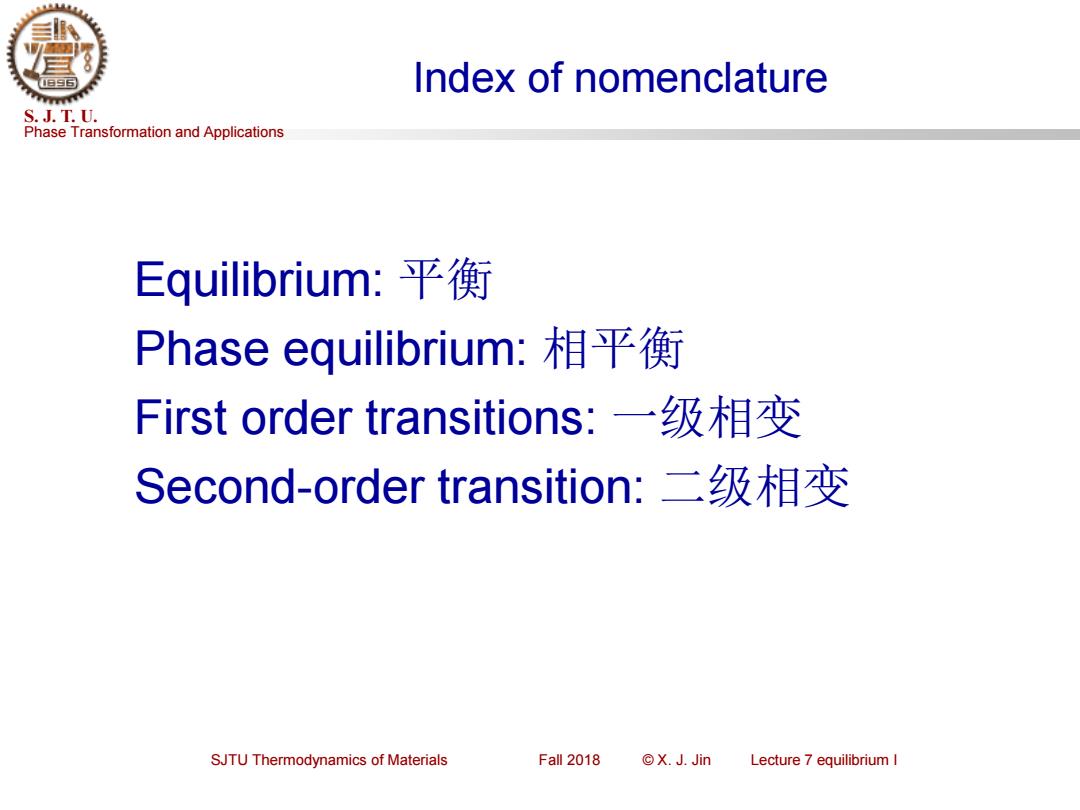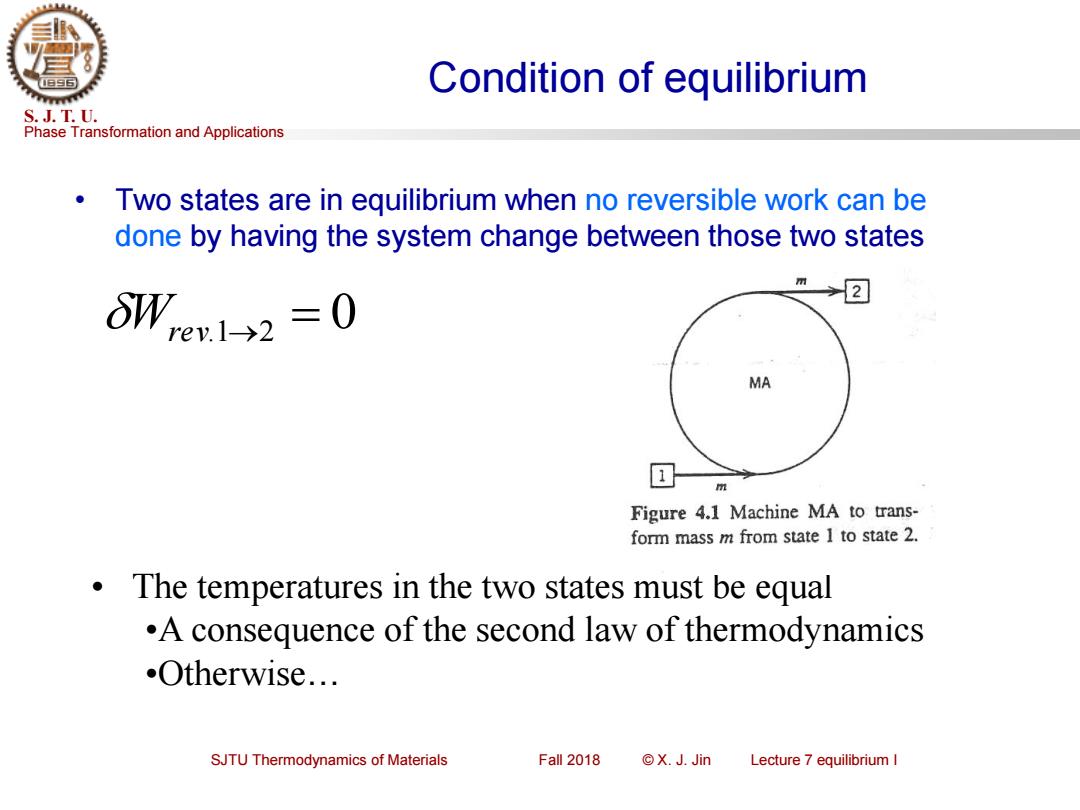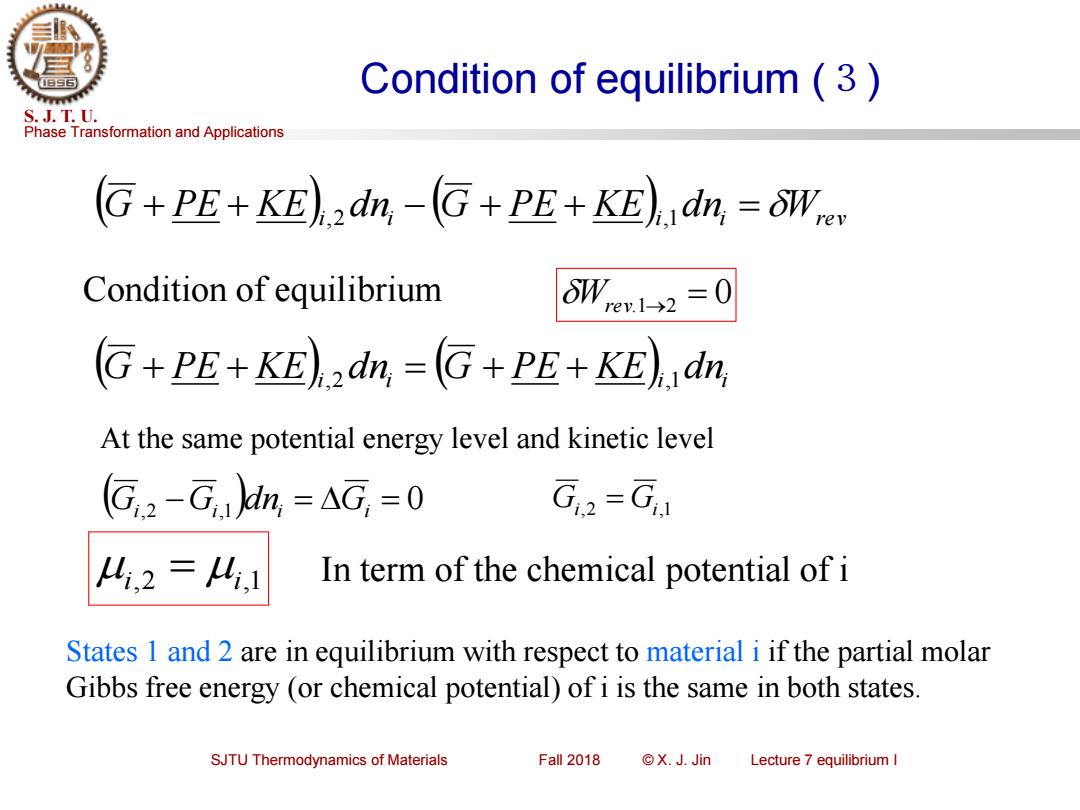
Index of nomenclature S.J.T.U. Phase Transformation and Applications Equilibrium:平衡 Phase equilibrium:相平衡 First order transitions:一级相变 Second-order transition:二级相变 SJTU Thermodynamics of Materials Fall 2018 ©X.J.Jin Lecture 7 equilibrium I
Phase Transformation and Applications S. J. T. U. SJTU Thermodynamics of Materials Fall 2018 © X. J. Jin Lecture 7 equilibrium I Index of nomenclature Equilibrium: 平衡 Phase equilibrium: 相平衡 First order transitions: 一级相变 Second-order transition: 二级相变

Introduction to equilibrium S.J.T.U. Phase Transformation and Applications The concept of equilibrium is fundamental Stable,unchanging with time and certain properties of the system are uniform throughout The system may not be homogeneous in form Co-existence of ice and water Phase A portion of matter that is uniform throughout,not only in chemical composition,but also in physical state - The usefulness of many metallic,polymeric,and ceramic systems depends on the presence,at equilibrium,of various different phases in the material 组织 SJTU Thermodynamics of Materials Fall 2018 ©X.J.Jin Lecture 7 equilibrium I
Phase Transformation and Applications S. J. T. U. SJTU Thermodynamics of Materials Fall 2018 © X. J. Jin Lecture 7 equilibrium I Introduction to equilibrium • The concept of equilibrium is fundamental • Stable, unchanging with time and certain properties of the system are uniform throughout • The system may not be homogeneous in form – Co-existence of ice and water • Phase – A portion of matter that is uniform throughout, not only in chemical composition, but also in physical state – The usefulness of many metallic, polymeric, and ceramic systems depends on the presence, at equilibrium, of various different phases in the material 组织

Condition of equilibrium S.J.T.U. Phase Transformation and Applications Two states are in equilibrium when no reversible work can be done by having the system change between those two states 2 6W,ev1->2=0 MA m Figure 4.1 Machine MA to trans- form mass m from state I to state 2. The temperatures in the two states must be equal .A consequence of the second law of thermodynamics .Otherwise... SJTU Thermodynamics of Materials Fall 2018 ©X.J.Jin Lecture 7 equilibrium I
Phase Transformation and Applications S. J. T. U. SJTU Thermodynamics of Materials Fall 2018 © X. J. Jin Lecture 7 equilibrium I Condition of equilibrium • Two states are in equilibrium when no reversible work can be done by having the system change between those two states Wrev.1→2 = 0 • The temperatures in the two states must be equal •A consequence of the second law of thermodynamics •Otherwise…

Condition of equilibrium(2) S.J.T.U. Phase Transformation and Applications Deal with partial molar quantities First law +PE+KE)a dn.-(+PE+KE).2dn2++W=du Second law 51-5,dm2+9 =ds T -TSdn.+TS,.dn.2-80+8w=-TdS The poperties of the machine do not change at steady state du-0and ds-0 G+PE+KE)dn2-G+PE+KE)dn.=OWc SJTU Thermodynamics of Materials Fall 2018 ©X.J.Jin Lecture 7 equilibrium I
Phase Transformation and Applications S. J. T. U. SJTU Thermodynamics of Materials Fall 2018 © X. J. Jin Lecture 7 equilibrium I Condition of equilibrium (2) dS T lw T Q Si dni −Si dni + − = ,1 ,1 ,2 ,2 (H + PE + KE)i,1 d ni,1 −(H + PE + KE)i,2 d ni,2 +Q +W = dU Deal with partial molar quantities −TSi,1 dni,1 +TSi,2 dni,2 −Q +lw= −TdS First law Second law The properties of the machine do not change at steady state dU=0 and dS=0 ( ) ( ) G + PE + KE i,2 d ni,2 − G + PE + KE i,1 d ni,1 = Wrev

Condition of equilibrium(3) S.J.T.U. Phase Transformation and Applications G+PE+KE)dn,-G+PE+KE)dn,=OW Condition of equilibrium W,e1-→2=0 G+PE+KE)dn,=G+PE+KE)dn, At the same potential energy level and kinetic level (G,2-G,)dn,=AG,=0 G,2-G 4,2=4,1 In term of the chemical potential of i States 1 and 2 are in equilibrium with respect to material i if the partial molar Gibbs free energy (or chemical potential)of i is the same in both states. SJTU Thermodynamics of Materials Fall 2018 ©X.J.Jin Lecture 7 equilibrium I
Phase Transformation and Applications S. J. T. U. SJTU Thermodynamics of Materials Fall 2018 © X. J. Jin Lecture 7 equilibrium I Condition of equilibrium (3) ( ) ( ) G + PE + KE i,2 d ni − G + PE + KE i,1 d ni = Wrev Condition of equilibrium Wrev.1→2 = 0 ( ) ( ) G + PE + KE i,2 d ni = G + PE + KE i,1 d ni (Gi,2 −Gi,1 )dni = Gi = 0 Gi,2 = Gi,1 At the same potential energy level and kinetic level i,2 = i,1 In term of the chemical potential of i States 1 and 2 are in equilibrium with respect to material i if the partial molar Gibbs free energy (or chemical potential) of i is the same in both states